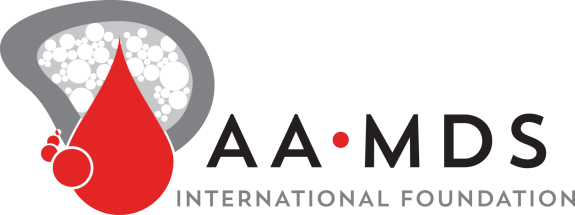News and Treatment Updates
Here's where you'll find a regularly updated, broad range of articles written by the AAMDSIF team, allied health organizations and news organizations. By staying well-informed, patients and families are practicing a form of self-support that will help them be more effective self-advocates when engaging with health care providers.
Finding His Way Through: Evan’s Story of PNH
Originally Published: 09/14/2025
Meet Evan. In a recent conversation with the Aplastic Anemia and MDS International Foundation, he shared his journey from paroxysmal nocturnal hemoglobinuria (PNH) diagnosis through treatment and survival.
Evan, please tell us a little about yourself.
I’m 31 years old. I’m based in New York City, and I’ve been living here for around eight years, after graduating from college. I’m working, enjoying life, spending time with friends, and just moving along.
What was your life like before the diagnosis of PNH?
I was biking a lot and extremely active. I had career goals, friends, and was planning...
Sensitivity of Pediatric Myelodysplastic Syndromes With Excess of Blasts With UBTF–TD to Venetoclax/Azacitidine
Originally Published: 09/04/2025
UBTF-TD has been reported in a significant percentage of childhood MDS-EB and has been associated with inferior survival compared to that of patients with the wild-type gene. We treated three consecutive pediatric patients affected by UBTF-TD MDS-EB with venetoclax and azacitidine (ven/aza) in combination as 28-day cycles on a compassionate use basis three consecutive pediatric patients affected by UBTF-TD MDS-EB as a bridge to allogeneic HSCT. Treatment with ven/aza was well-tolerated, and all patients responded to the ven/aza course, achieving CR with flow-cytometry negativity. All three...
Germline and somatic genetic landscape of pediatric myelodysplastic syndromes
Originally Published: 09/01/2025
Abstract
Pediatric myelodysplastic syndromes (MDS) represent a rare group of clonal hematopoietic stem cell disorders accounting for approximately 5% of pediatric hematologic malignancies. They are characterized by ineffective hematopoiesis, cytopenia, and dysplastic changes in the bone marrow with variable risk of progression to acute myeloid leukemia. Unlike adult MDS, pediatric cases predominantly present with hypocellular bone marrow, with monosomy 7 and trisomy 8 as the most common cytogenetic aberrations. Pediatric MDS can manifest as primary disease or arise secondary to classical...
A clinical guide to TP53 mutations in myeloid neoplasms
Originally Published: 08/29/2025
TP53 mutations are found in 10-15% of myeloid neoplasms and are one of its most important prognostic factors. Emerging data show that TP53 mutational allele status is a key determinant of clinical outcomes, with multi-hit TP53 mutant myeloid neoplasms having a very poor prognosis. Significant differences exist among the methods used in clinical and research settings to assess TP53 mutational status, leading to variability in reported patient characteristics, response to therapy, and survival. Indeed, differences in the criteria used to define TP53 mutational states among professional...
Correlates and consequences of clonal hematopoiesis expansion rate: a 16-year longitudinal study of 6976 women
Originally Published: 08/28/2025
Abstract
Clonal hematopoiesis of indeterminate potential (CHIP) is associated with increased mortality and malignancy risk, yet the determinants of clonal expansion remain poorly understood. We performed sequencing at a depth of coverage of >4000× for CHIP mutations in 6976 postmenopausal women from the Women’s Health Initiative (WHI) at 2 time points: the WHI baseline examination and ∼16 years later at the Long Life Study (LLS) visit. Among 3685 CH mutations detected at baseline (variant allele fraction [VAF] of ≥0.5%), 24% were not detected at LLS, 26% were micro-CH at LLS (0.5% ≤ VAF...
Outcomes and Patterns of Relapse of NPM1 Mutated Acute Myeloid Leukemia Treated With Venetoclax Based Therapies
Originally Published: 08/28/2025
To the editor,
Mutations in nucleophosmin 1 (NPM1-mut) are detected in approximately 30% of newly diagnosed (ND) acute myeloid leukemia (AML), and are considered founder events due to their persistence at relapse [1]. While treatment with both intensive chemotherapy (IC) and low-intensity therapy (LIT) is associated with favorable responses in NPM1-mutated AML, relapses are common, occurring in approximately 50% of IC-treated and more frequently with LIT-treated patients [1, 2].
Recent data suggests that NPM1 wildtype (NPM1-wt) relapses occur in up to 5%–10% of NPM1-mut AML treated with...
Factors affecting treatment decisions for lower-risk myelodysplastic syndromes across practice settings
Originally Published: 08/25/2025
Please find all content at the link.
Pivotal results of SELECT-MDS-1 phase 3 study of tamibarotene with azacitidine in newly diagnosed higher-risk MDS
Originally Published: 08/13/2025
Abstract
Higher-risk myelodysplastic syndrome (HR-MDS) with RARA gene overexpression is a subset of patients (pts) with an actionable target for tamibarotene, an oral and a selective retinoic acid receptor-α (RAR-α) agonist. Tamibarotene with azacitidine (AZA) showed complete remission (CR) rates in myeloid leukemia. SELECT-MDS-1 was a phase 3 study comparing the activity of tamibarotene + AZA to placebo + AZA in these pts with newly diagnosed HR-MDS with RARA overexpression. Eligible pts had confirmed RARA overexpression, untreated MDS with higher-risk features by revised International...
Impaired cytotoxic function and exhausted phenotype of natural killer cells in VEXAS syndrome
Originally Published: 07/30/2025
Key Points
NK cells phenotyping reveals impaired cytotoxicity, chronic activation and exhaustion in VEXAS syndrome.
Decreased circulating NK cells were independently associated with an increased risk of severe infections in VEXAS syndrome.
VEXAS (vacuoles, E1 enzyme, X-linked, autoinflammatory, somatic) syndrome is an autoinflammatory disorder caused by acquired somatic UBA1 mutations in hematopoietic stem cells, affecting peripheral myeloid and natural killer (NK) cells. Given the high rate of severe infections observed in VEXAS patients, we hypothesized that NK cell dysfunction contributes...
IHC Testing Could Serve as Surrogate to NGS for Early Detection of TP53-Mutant MDS/AML
Originally Published: 07/29/2025
Immunohistochemistry (IHC) could represent a biomarker for the early detection of TP53 mutations and for the prediction of a TP53 allelic state in patients with myelodysplastic neoplasms (MDS) and acute myeloid leukemia (AML), according to data from an observational trial (NCT01174615) published in Cancer.
Findings demonstrated that among evaluable samples (n = 145), the mean percentage of cells with positive staining was 28% (±3.67%) for AML samples compared with 8.8% (±1.61%) for MDS samples (P < .001). Within the MDS subset, the mean percentage of cells with positive p53 staining was...

